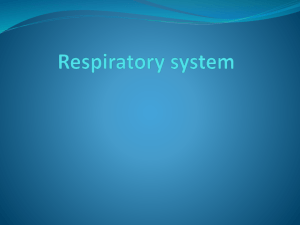Differential Diagnoses in Pulmonary Disease
advertisement
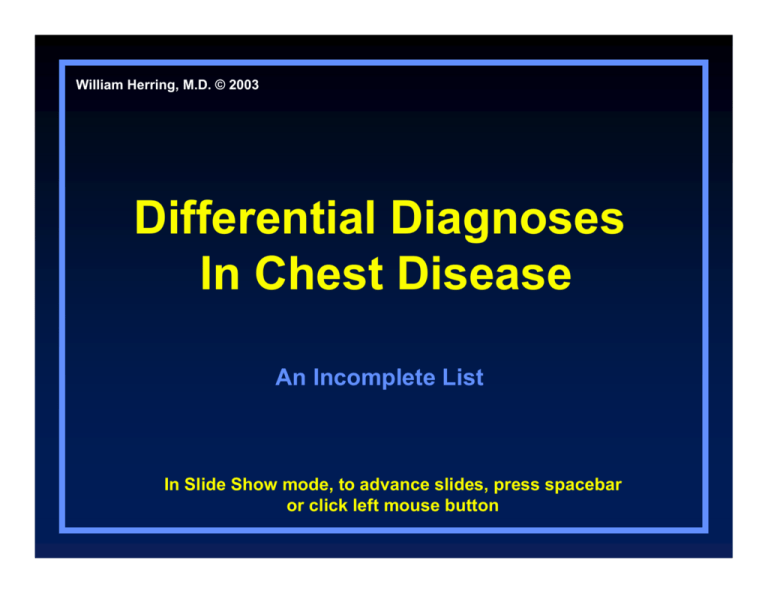
William Herring, M.D. © 2003 Differential Diagnoses In Chest Disease An Incomplete List In Slide Show mode, to advance slides, press spacebar or click left mouse button How to Use This File And How Not to Use It ● Use the bookmarks on the left as cues for the differentials ● Try to recite the differential without looking ● Then click on the bookmark for the answers ● The file can be used like “flashcards” ● These lists are not meant to be all-inclusive so please do not consider them as such. If you wish all-inclusive lists of differentials, consult the appropriate textbooks Acute Alveolar infiltrate 1. Pulmonary edema 2. Pneumonia 3. Aspiration 4. Hemorrhage Anterior Mediastinal Masses 1. Thymoma 2. Teratoma 3. Substernal thyroid 4. Lymphoma Opacified Hemithorax 1. Atelectasis 2. Pleural effusion 3. Pneumonia 4. Post-pneumonectomy Pneumomediastinum 1. Ruptured esophagus 2. Ruptured trachea/bronchus 3. Iatrogenic 4. Asthma 5. Pneumoperitoneum Chronic Alveolar Disease 1. Alveolar cell ca 2. Alveolar sarcoid 3. Lymphoma 4. Alveolar proteinosis Large Cavitary Lung Lesions 1. Abscess 2. Carcinoma 3. TB Bibasilar Interstitial Disease 1. Bronchiectasis 2. Aspiration 3. DIP 4. Asbestosis 5. Sickle Cell Disease 6. Scleroderma Upper Lobe Disease 1. TB (2° TB) 2. Silicosis 3. Eosinophilic granuloma 4. Ankylosing spondylitis Micronodular Lung Disease 1. Mets 2. Sarcoid 3. Pneumoconiosis 4. Miliary TB Chronic Interstitial Disease Pulmonary Fibrosis 1. Pneumoconiosis 2. Interstitial Pneumonia 3. Granulomatous disease 4. Neoplastic disease 5. Idiopathic fibrosis 6. Collagen vascular disease Small Cavitary Lung Lesions 1. Septic emboli 2. Rheumatoid nodules 3. Squamous or transitional cell mets 4. Wegener’s Granulomatosis Lymphangitic Spread to the Lungs 1. Lung ca 2. Breast ca 3. Stomach ca 4. Pancreas ca 5. Laryngeal ca 6. Cervical ca Multiple Lung Nodules 1. Mets 2. Wegener’s granulomatosis 3. Rheumatoid nodules 4. AVMs 5. Septic emboli Pulmonary Interstitial Edema 1. CHF 2. Lymphangitic spread 3. Allergic reaction Shifting Infiltrates 1. Loeffler’s syndrome 2. ABPA 3. Asthma 4. Polyarteritis 5. Viral pneumonia Unilateral Hyperlucent Lung 1. Swyer-James syndrome 2. Pulmonary embolism 3. Pneumothorax 4. Obstructive emphysema Rapidly Clearing Alveolar Infiltrate 1. Hemorrhage 2. Pulmonary edema 3. Aspiration 4. Pneumococcal pneumonia Cavitating Pneumonia 1. Staph 2. Strep 3. TB 4. Gram negative (Klebsiella) Middle Mediastinal Masses 1. Lymphadenopathy 2. Aneurysms 3. Esophageal duplication 4. Bronchogenic cysts Masses with Air Bronchograms 1. Lymphoma 2. Alveolar cell ca 3. Pseudolymphoma (Maltoma) Hilar Adenopathy 1. Sarcoid 2. TB 3. Lymphoma 4. Bronchogenic ca 5. Mets Cavities Containing Masses 1. Aspergillosis 2. Cavitating bronchogenic ca 3. Tuberculosis 4. Hydatid cyst Infiltrates with Effusion 1. Staph pneumonia 2. Strep pneumonia 3. TB 4. Pulmonary infarct “Mass”+ ipsilateral adenopathy 1. Bronchogenic ca 2. Lymphoma 3. TB Solitary Pulmonary Nodule 1. Bronchogenic ca 2. Hamartoma 3. Histoplasmoma 4. TB granuloma 5. Bronchial adenoma 6. Solitary met 7. Round pneumonia 8. Rounded atelectasis Pleural Effusion 1. 2. 3. 4. 5. 6. 7. 8. 9. CHF Mets Pancreatitis Pulmonary embolism Trauma Empyema Collagen vascular Ovarian tumor (Meig’s Syndrome) Chylothorax Left-sided Pleural Effusion 1. Boerhaave’s Syndrome 2. Dissecting aortic aneurysm 3. Pancreatitis 4. Distal thoracic duct rupture Multiple Small Calcifications 1. Histoplasmosis 2. Silicosis 3. Chicken pox pneumonia 4. Pulmonary ossification 2° MS 5. Alveolar microlithiasis Posterior Mediastinal Masses 1. Neurogenic tumors 2. Lymphadenopathy 3. Extramedullary hematopoesis Mediastinal Adenopathy 1. Bronchogenic ca 2. Lymphoma 3. TB 4. Mets 5. Sarcoid Lung Disease & Rib Destruction 1. Bronchogenic ca, i.e Pancoast tumor 2. Actinomycosis 3. Blastomycosis 4. Multiple myeloma Pleural Calcification 1. Old TB empyema 2. Asbestos exposure 3. Hemothorax “Masses” in Cardiophrenic Angle 1. Sequestration 2. Diaphragmatic hernia 3. Pericardial cyst Unilateral Pulmonary Edema 1. Aspiration 2. Disease in other lung, e.g. COPD 3. Postural 4. Rapid expansion of PTX Reverse “Pulmonary Edema” 1. Eosinophilic lung disease, e.g. Loeffler’s 2. Sarcoid 3. Pulmonary contusions

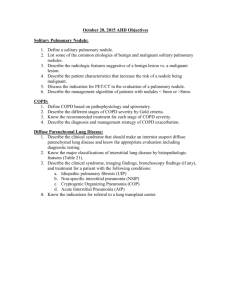

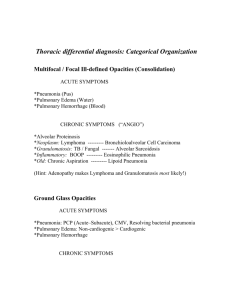
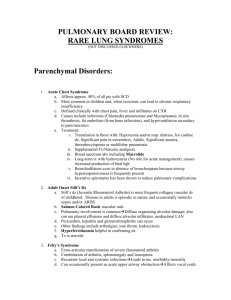

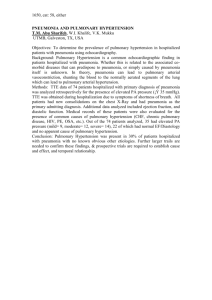
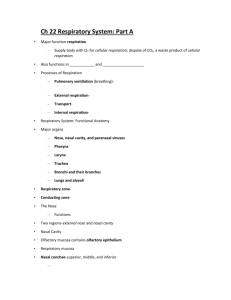
![THE DISEASES OF THE RESPIRATORY SYSTEM[1].](http://s3.studylib.net/store/data/008993121_1-37dd5d5f6d208d22af489a33c6400f83-300x300.png)
